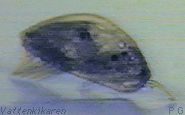 |
|
Good and bad years
For those cliff and rocky beach organisms that
have a planktonic distribution stage there are two factors that have a large
effect on their population densities in different areas:
(1) The size of the population within a certain area is dependent of how
many individuals survived the journey to the area in question, and
(2) how well they etablish themselves upon arrival.
Many organisms die during their journey. Many individuals are for example
carried away from coastal areas and never get a chance to establish themselves
on a beach. Others are eaten by other creatures during their journey. Many
larvae are an important source of food for plankton and fish.
Most larvae must live in the open water for a certain period
of time to allow them to eat and grow before they can attach themselves
to a solid foundation and became bottom dwellers. When a larva is mature
enough to attach to some form of foundation it usually investigates the
surroundings to determine if it is suitable. This moment, when it is falling
towards the bottom is often critical and also a time when many larvae die.
First they have to find a free area with the right stimulus to aid their
change to a bottom-living stage. Then they have to survive the metamorphosis
from a free swimming larva to an attached individual. Even if everything
goes well, individuals still have to cope with living on its foundation
until it reaches adulthood and can produce its own larvae in large enough
quantities so that enough of them also reach adulthood and can themselves
reproduce.
| <A href="../../arter/mollusca/prosobra/gastveli/gastve.mov">[Watch
a periwinkle larvae swim! 941 kB]</A> |
 |
| In the film on the left, a perwinkle larva is seen.
It is swimming around catching food so that it can grow into a fully
developed bottom-living periwinkle. To the right, a barnacle
larva (cypris) is seen. It has became so large and well developed
so that it is looking for a place where it can attach itself and
change to the adult stage. Both larvae have been magnified in a
microscope. |
 |
Page 39 of
52 |
 |
|
| Cliffs
and rocks are fantastic! |
| Zoning
and flecked occurrence |
| Animals
that are attached |
| Modular
construction |
| Variation
and change |
| Variations
in water level |
| Wave
exposure |
| Both
cliffs and rocks |
| Freshwater
and saltwater |
| Geography,
climate and history |
| Organisms
life cycles |
| Organisms
effect on each other |
| Energy
and the flow of material |
|


